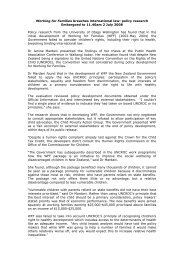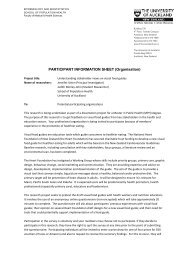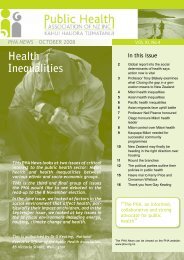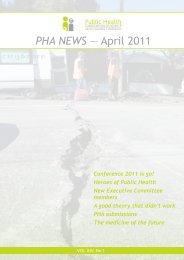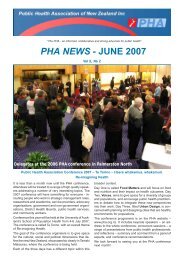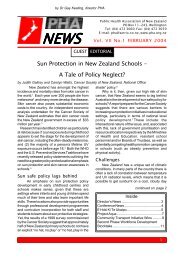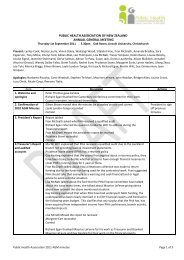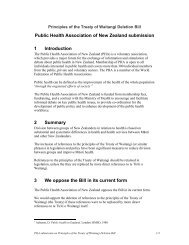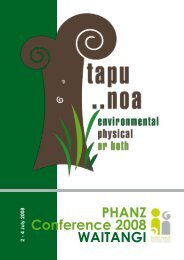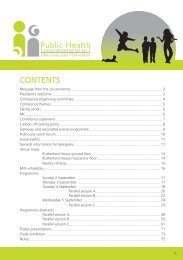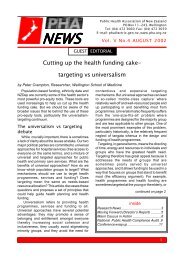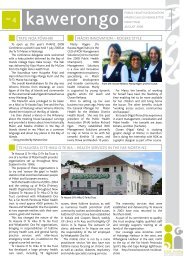August 2012 - Public Health Association of New Zealand
August 2012 - Public Health Association of New Zealand
August 2012 - Public Health Association of New Zealand
- No tags were found...
You also want an ePaper? Increase the reach of your titles
YUMPU automatically turns print PDFs into web optimized ePapers that Google loves.
From the President<strong>New</strong> PHA CEOThe PHA ExecutiveCouncil is delightedto announce theappointment <strong>of</strong> new CEOWarren Lindberg.Warren is a longstandingPHA member and a leaderwithin the public healthcommunity. He is anexperienced not-for-pr<strong>of</strong>itCEO, well versed withframeworks and evidence useful to public health analysis,and an articulate public and media spokesperson.Since March 2007 Warren has been Group Manager,<strong>Public</strong> <strong>Health</strong> (now part <strong>of</strong> the Ministry <strong>of</strong> <strong>Health</strong>’s National<strong>Health</strong> Board) where he was responsible for contractingpublic health services, including those with nongovernmentorganisations.However he is best known for his 12 years as the firstExecutive Director <strong>of</strong> the <strong>New</strong> <strong>Zealand</strong> AIDS Foundation(1986 to 1998), and as Manager <strong>of</strong> the Project to CounterStigma and Discrimination Associated with Mental Illnessfrom 1999 to 2001, including the launch <strong>of</strong> the mass mediacampaign “Like Minds, Like Mine”.Warren has been a Human Rights Commissioner (2001-2006), a lecturer in management in the Bachelor <strong>of</strong>Community Practice at Unitec, a team manager in theAuckland Regional <strong>Public</strong> <strong>Health</strong> Service and <strong>Public</strong><strong>Health</strong> Planner with the Northern DHB Support Agency .In 1999 he was made a Member <strong>of</strong> the <strong>New</strong> <strong>Zealand</strong>Order <strong>of</strong> Merit for services to welfare.Warren says the public health sector has given him greatopportunities over the last 26 years.“I’ve been able to contribute my passion (and hopefullysome modest skills) towards better health for communitieswith which I have closely identified.“Working in the Ministry, with responsibility for funding thesector I had been a part <strong>of</strong>, has challenged me in ways Icould not have anticipated. I now know a lot more aboutdoing more for less.“As Lord Rutherford reputedly said, ‘We didn’t have themoney so we had to think.’”The PHA was established to provide leadership in thinkingabout <strong>Public</strong> <strong>Health</strong>, and Warren says he feels veryprivileged at this new opportunity to work collaboratively tohelp improve health for all <strong>New</strong> <strong>Zealand</strong>ers.Warren will start with the PHA on Sunday 2 September atthe Executive Council meeting leading into the WellingtonGateway Events and conference.The Executive Council would also like to say a very bigthank you to Janice Burns who has been Acting Managersince November 2011. She and the team have updated alot <strong>of</strong> PHA systems and processes, and Janice has workedwith the Executive Council to enter negotiations with theMinistry <strong>of</strong> <strong>Health</strong> around our contract as a consequence<strong>of</strong> the alignment review conducted by Bruce MacDonald.Janice has been consulting with branches and caucusesaround other recommendations from the review whileworking with PHA staff around submissions and ourcontract. She has also begun some <strong>of</strong> the planning workaround our organisation’s increased membership focus.Janice and Warren will be having a formal handoversession and Janice has kindly <strong>of</strong>fered to remain on handto help with queries once Warren has taken over the reins,which bodes well for a seamless handover.With the appointment <strong>of</strong> a new CEO a new chapter willunfold for the PHA. We will continue to move forwardand learn from our history and rise to challenges andopportunities in the environment around us.I am sure you will all join me and the Executive Council inwelcoming Warren to this critical public health leadershipand influence role.Review updateAs members will know, the PHA Executive Councilcommissioned a “whole <strong>of</strong> organisation alignmentreview” <strong>of</strong> the PHA, which was conducted by BruceMacdonald and completed in March this year.The purpose <strong>of</strong> the review was to examine the structure,roles, capacity and finances <strong>of</strong> the organisation to ensureit is in the best position to meet present and futurechallenges.The review affirms there is a clear and ongoing role forthe PHA as an umbrella voluntary association for all thosein public health. The PHA potentially provides a means<strong>of</strong> collective focus across a wide range <strong>of</strong> disciplines/pr<strong>of</strong>essions/occupations within the sector. But to achievethis, the PHA must be an organisation that provides realand perceived value to its members, and that has broadappeal to the wide range <strong>of</strong> public health groups andindividuals.A key theme <strong>of</strong> the review was that there is enormouspotential for the PHA to grow in terms <strong>of</strong> membershipand effectiveness by demonstrating its relevance andimportance to members, to potential members, andto those who work in similar public health workforceorganisations.The review was largely about assessing how well the PHAis achieving this, and how things could change so we canachieve it better.2PHA <strong>New</strong>s <strong>August</strong> <strong>2012</strong>
In this issue:From the President 2What has the PHA beendoing for you?4A farewell to Dr AlisonBlaiklock5Warren Lindberg<strong>Health</strong>y skin – a publichealth success story6The review makes recommendations around the PHA’sinternal and external alignment and you can read aboutthese in the summary report. The recommendations had todo with the PHA’sAround the branches 7• strategic focus and work plan• Executive Council composition• staff composition• relationship with the Ministry <strong>of</strong> <strong>Health</strong>• bilateral relationships• annual conference• finances• membershipand more.He taonga te mokopuna –the child is specialPost Budget Breakfasts<strong>2012</strong>910The Executive Council is excited about the road aheadin light <strong>of</strong> the review and will intend keep members up-todatewith further developments as they arise.However, if you have remaining questions – about eitherthe review or the chief executive <strong>of</strong>ficer role – you arewelcome to contact me: monicabriggs@xtra.co.nz.Conference <strong>2012</strong> 12While the main report remains confidential to the ExecutiveCouncil, a summary report has been prepared and isavailable to all members atwww.pha.org.nz/documents/Summary-PHA-Review-May-<strong>2012</strong>.pdf.Monica BriggsPHA PresidentChanging the language <strong>of</strong>public health14Vol XV No 2 PHA <strong>New</strong>s3
What has the PHA been doing for you?PHA staff at a breakfast celebrating Matariki in Wellington; from left to right: Keriata Stuart (Strategic Advisor, Māori <strong>Public</strong> <strong>Health</strong>),Janice Burns (Acting Manager), Leona Head (Administration and Membership Manager), Diane Reay (Office Assistant)So far, <strong>2012</strong> feels like it’s been a non-stop round<strong>of</strong> developing submissions, presenting to SelectCommittees, and talking about submissions to themedia.The major focus <strong>of</strong> the year has been child wellbeing anddevelopment.For many years, organisations such as the PHA have beentrying to get politicians and media interested in improvingthe health and wellbeing <strong>of</strong> <strong>New</strong> <strong>Zealand</strong> children.In <strong>2012</strong> it looks as though the issue has finally cometo the fore. So far we’ve had the government’s GreenPaper for vulnerable children, the Māori Affairs SelectCommittee inquiry into the determinants <strong>of</strong> wellbeing forMāori children, and the <strong>Health</strong> Select Committee’s inquiryinto preventing child abuse and improving children’shealth outcomes – and sometimes even PHA staff wereconfused about which inquiry we were dealing with!However, the PHA has taken a consistent approach,encouraging government to take action on the ‘causes<strong>of</strong> the causes’ <strong>of</strong> <strong>New</strong> <strong>Zealand</strong>’s poor child outcomes,including housing, income and other disparities.When we presented to the Māori Affairs Select Committee,we urged government to introduce child/tamariki impactassessment. This would mean that that all new central andlocal government initiatives would be tested for their likelyimpact on tamariki Māori, and all <strong>New</strong> <strong>Zealand</strong> children.The PHA’s Keriata Stuart told the committee that notonly would this stop many policies having unintendedconsequences for children but, more importantly, it wouldmean children being seen as worth taking notice <strong>of</strong>, and asa national asset to be invested in, rather than as a cost asat present.Reducing child poverty was also the topic from this year’sPost-Budget Breakfast in Wellington. The PHA took theinitiative to bring together many <strong>of</strong> the groups who havebeen active in making submissions and advocating forchildren, including Every Child Counts, Plunket, Unicef,the Cancer Society and the <strong>New</strong> <strong>Zealand</strong> NursesOrganisation.We’re continuing to work collaboratively with these andother organisations to seize the opportunity <strong>of</strong> making realchange for <strong>New</strong> <strong>Zealand</strong> children.4PHA <strong>New</strong>s <strong>August</strong> <strong>2012</strong>
<strong>Health</strong>y skin –a public healthsuccess storyThose working in public health can <strong>of</strong>ten feel likethey’re “up against it”. The foresight <strong>of</strong> preventioncan be a struggle in an environment where thereare insufficient resources or too many policychallenges. So it’s great, every now and then, tocome across a story that helps us celebrate whatcan and has been successfully done in publichealth. Keeping Well’s ‘<strong>Health</strong>y Skin in GreaterWellington’ initiative is just such a story.Keeping Well is the population health strategy forthe Wellington region and its implementation isled by Regional <strong>Public</strong> <strong>Health</strong>.By 2010, Wellington and Hutt Valley DHB data showedthat, for children under 14 years, 65.7 per 10,000 werebeing admitted to hospital with serious skin infections. Thiswas quite a shocking increase from 1996/7 figures <strong>of</strong> just15.4 per 10,000.What’s more, there were the usual ethnic and socialdisparities with the significant majority <strong>of</strong> children admittedcoming from Māori and Pacific families, and from thepoorer parts <strong>of</strong> greater Wellington.Alarmed by these increases, Regional <strong>Public</strong> <strong>Health</strong>reviewed what it was doing about serious skin infectionsand organised an inter-disciplinary hui attendedby representatives from the DHBs, Primary <strong>Health</strong>Organisations and numerous health providers andgovernment agencies.Together they formed an initiative called <strong>Health</strong>y Skinin Greater Wellington and developed a Roadmap forcombating the increasing burden and disparities <strong>of</strong> seriousskin infections among children.The Roadmap identified a number <strong>of</strong> required actionareas, but one <strong>of</strong> the most significant was ensuringa common approach to the prevention, assessment,management and treatment so that health pr<strong>of</strong>essionalsacross the region were consistent in the treatment andadvice they provided.To achieve this more standardised approach <strong>Health</strong>y Skinin Greater Wellington was supported by five resources,mainly focussed on children.The first resource, the <strong>Health</strong>y Skin Tool, was originallyfor clinicians to use to educate their patients about skininfections, how they should be treated and how to avoidthem in future. However, it quickly also began to be usedmore widely by other community organisations highlightinga widespread recognition <strong>of</strong> the problem in the region.The <strong>Health</strong>y Skin Tool uses pictures to feature fivedifferent stages <strong>of</strong> the development <strong>of</strong> a serious skininfection (using traffic light colours), from healthy to inneed <strong>of</strong> hospitalisation, and lists advice and guidelines fordealing with each stage.“One significant achievement is that thesame messages about skin health arestarting to be used by the health sector andthe wider community across the region.”The resource has been in circulation since November2011, and, based on feedback, an updated version isabout to be released.While it is too early to <strong>of</strong>ficially evaluate the success <strong>of</strong> thisresource alone, Barry Gall, a Senior <strong>Public</strong> <strong>Health</strong> Advisorat Regional <strong>Public</strong> <strong>Health</strong>, said the <strong>Health</strong>y Skin Tool hadbeen very widely welcomed.“We’ve had people asking for the resource from all aroundthe country and, at the request <strong>of</strong> some stakeholders,we’ve adapted the tool for adult cellulitis.”The second resource is a set <strong>of</strong> protocols for healthpr<strong>of</strong>essionals aimed at promoting evidence-basedpractice for the prevention, assessment, management andtreatment <strong>of</strong> skin infections in people <strong>of</strong> 25 years <strong>of</strong> ageand under.Endorsement for the final version is currently being6PHA <strong>New</strong>s <strong>August</strong> <strong>2012</strong>
<strong>Health</strong>y skin Minor cut, sore or other Minor skin infection Skin infection that isskin conditiongetting worseSerious skin infectionsought from several DHB and PHO clinical and qualitycommittees.The third and fourth resources are targeted directly atparents and children, and include a poster, postcards,stickers and a colouring-in sheet that present basic healthyskin messages, such as CLEAN , CUT, COVER; CLEANhands <strong>of</strong>ten, CUT nails and wash and COVER sores andcuts.Based on feedback, these resources are simple and clear;show healthy, happy children to draw in the reader; andgive succinct advice about treatment for a skin infections.The final resource is the Skin <strong>Health</strong> Supports Directory, aguide to the many resources and services available in theregion that support families and whānau to better manageskin conditions and infections.It contains practical information on first aid and infectionprevention as well as medication and financial supports.<strong>Public</strong> <strong>Health</strong> Physician Dr Ruth Richards says theresources are already achieving some success.“One significant achievement is that the same messagesabout skin health are starting to be used by the healthsector and the wider community across the region.Patients are getting the same advice wherever they turnup.“And although any change cannot be attributed solelyto these resources, we are anecdotally hearing thatpresentations to hospitals are reducing.”Combined, these resources address the need for amore focussed approach to the prevention, assessment,management and treatment <strong>of</strong> skin infections in children,and that’s great public health news.Regional <strong>Public</strong> <strong>Health</strong> will <strong>of</strong>ficially launch the resourcesin <strong>August</strong> <strong>2012</strong>.Around the branchesHere’s a roundup <strong>of</strong> what some <strong>of</strong> the branches have been up to since the last PHA <strong>New</strong>s.Welcome back Auckland!The PHA is pleased to announce the re-forming <strong>of</strong> theAuckland PHA Branch, consisting <strong>of</strong> Nicole Coupe andSitaleki Finau (co-chairs) along with Bruce Macdonald andIsis McKay (co-treasurers/co-secretaries).Nicole Coupe Sitaleki Finau Isis McKay Bruce MacdonaldThe branch re-formed in the beginning <strong>of</strong> April and had itsfirst meeting to determine the future structure and committee. At our next meeting we are looking forward to creatingvision and direction for the Auckland branch. We would appreciate any ideas from Auckland branch members and lookforward to meeting in July.Nicole Coupe has a PhD in Whakamomori: Māori suicide prevention and feels privileged to be elected co-chair <strong>of</strong> theAuckland Branch. She has worked as an academic researcher using kaupapa epidemiological methodologies to improveMāori health outcomes for the last 14 years. Until recently she managed the <strong>Public</strong> <strong>Health</strong> Groups Infrastructure Teamwithin the National <strong>Health</strong> Board.Siteleki Finau is the Pr<strong>of</strong>essor <strong>of</strong> Pacific <strong>Health</strong> Development at the School <strong>of</strong> <strong>Public</strong> <strong>Health</strong>, Massey University, and amember <strong>of</strong> the <strong>of</strong> the <strong>New</strong> <strong>Zealand</strong> Order <strong>of</strong> MeritIsis McKay is the Maternal and Child <strong>Health</strong> Promoter at Women’s <strong>Health</strong> Action. She also chairs the Metro AucklandBreastfeeding Network and sits on various consumer and stakeholder groups.Bruce Macdonald has qualifications and work experience in social work, law and public health. He has worked as a publichealth planner and funder with North <strong>Health</strong>, the <strong>Health</strong> Funding Authority and the Ministry <strong>of</strong> <strong>Health</strong>. From 2000 to 2004he managed the Ministry <strong>of</strong> <strong>Health</strong>’s <strong>Public</strong> <strong>Health</strong> Team in the Northern Region.Vol XV No 2 PHA <strong>New</strong>s7
Asian CaucusLifeng ZhouAsian Caucus RepresentativeThe Asian Caucus is working on the Asian PHO enrolment project to improve enrolment with GPs andaccess to primary care in the Auckland region.Two presentations will be made at the Fifth International Asian and Ethnic Minority <strong>Health</strong> and Wellbeing Conference<strong>2012</strong>, with one on “Reflections on health needs <strong>of</strong> Asians and the strategies for improving Asian health”.An Auckland regional cervical screening governance group has just been set up on behalf <strong>of</strong> the Asian/migrantcommunities, with Dr Lifeng Zhou providing epidemiologic expertise. The cervical screening rates <strong>of</strong> Asians are verylow when compared with Europeans.There is also a plan to have the first caucus meeting <strong>of</strong> Asian PHA members this year.Māori CaucusWaitangi WoodMāori Caucus RepresentativeWe are pleased to announce that the Māori Caucus will be facilitating the National PHA Conference 2013.The theme for the conference is Partnership. We will be catching up with Maori Caucus members andother Branch Members whohave expressed an interest in being part <strong>of</strong> the Conference 2013 development.If you would like to advise your interest in being part <strong>of</strong> the Convening Group, please email Waitangi Wood:waicommunications@gmail.com.Otago/Southlandthe year.Jean SimpsonOtago/Southland Branch RepresentativeThe PHA/Department Seminar Series has continued to run smoothly. You will notice it has been moved toa lunchtime slot. So far there have been favourable comments, but that decision will be revisited later inMembership continues to be a major challenge for us: one that is shared with many other PHA branches nationallyand internationally.We have work to do to re-engage with the public health sector working in the District <strong>Health</strong> Board. We have work todo to increase our engagement with the academic community, and I think we have to think beyond the traditional areasto recognise, support and seek collaboration with people working in a range <strong>of</strong> NGOs that we may not necessarilyseen as doing public health, but who have common concerns and values.Canterbury-West CoastMartin WittCanterbury-West Coast RepresentativeMid-year finds the Canterbury-West Coast branch with some new faces.In June we held our AGM at which we sadly said farewell to Lynley Cook, who, as Chair, provided sterlingleadership and encouragement to the branch following the February 2011 earthquake. Lynley was, in no small way, thedriving force behind the branch’s decision to continue with its role as conference host in 2011, despite the need to finda new venue. We will miss her contributions to the branch and trust that she will return before long.At the AGM, members were also treated to a reflection on public health over the last 30 years by long time memberAssociate Pr<strong>of</strong>essor Pauline Barnett (<strong>Public</strong> <strong>Health</strong> Champion 2004). Pauline has also stepped down from branchactivities and Canterbury-West Coast owes Pauline a huge amount for her drive, enthusiasm and teaching on manyaspects <strong>of</strong> public health – thank you!At the same time we welcomed Dr Rachel Eyre as our new Chair. Rachel is a <strong>Public</strong> <strong>Health</strong> Medicine Specialist with abackground in rural health, health promotion, policy analysis and health services research, now working at the SouthIsland Alliance Programme Office. We confirmed Lynne Haslett as our Treasurer and Nicola Laurie as Secretary.The branch is now looking forward to developing its advocacy strategy as well as to planning a branch seminar later inthe year.8PHA <strong>New</strong>s <strong>August</strong> <strong>2012</strong>
On 25 May the PHA Wellington and the Child Poverty Action Group hosted the annual WellingtonPost-Budget Breakfast with the theme “How do children fare?” Similar breakfasts were held inAuckland, Whangarei and Christchurch.Here are some speaker snapshots from the various Breakfasts.Sue Bagshaw, University <strong>of</strong> Otago, (Christchurch Breakfast)<strong>New</strong> <strong>Zealand</strong>’s pipeline policy approach to dealing with youth denies them the opportunity tocontribute, participate and flourish on their own terms.A worrying change is the way school data, including reports, are being forwarded to theMinistry <strong>of</strong> Social Development without the child’s or parent’s permission. Regardless <strong>of</strong>whether they were from a period where a young person was troubled, this information wouldpermanently stay on their record, potentially preventing them from ever making a fresh start.<strong>New</strong> <strong>Zealand</strong> and Finland are countries with similar problems <strong>of</strong> youth suicide, but very differentapproaches to taxation, wellbeing, and strategies for youth unemployment. Youth suicide in Finland isdeclining, but continuing to rise in <strong>New</strong> <strong>Zealand</strong>.Bronwyn Hayward, University <strong>of</strong> Canterbury, (Christchurch Breakfast)<strong>New</strong> <strong>Zealand</strong> has the highest youth unemployment rates inthe OECD at 45 percent. This, along with poorchild outcomes as measured by UNICEF and the OECD, reflects a growing intergenerational inequality.We’ve cut <strong>of</strong>f options for them to stay in tertiary training after four years, we have no new schemesfor senior secondary public education despite having the worst record in the OECD at keeping highschoolteens in education, and now we’re making incremental cuts to primary education and effectivelyprivatising early childhood education. So what do we expect our young people to do?Now, greater burdens are being shifted onto our youth while the wealthy get tax breaks.Susan St John, University <strong>of</strong> Auckland, (Auckland Breakfast)This Budget does not mention the plight <strong>of</strong> many children and families. Unlike the AustralianBudget, which acknowledged the financial pressures families face, there were no words <strong>of</strong>empathy for struggling families.<strong>New</strong> <strong>Zealand</strong> is already seriously indebted, and the current account deficit is only projectedto get worse. However, the Finance Minister’s optimistic forecasts <strong>of</strong> growth do not stack upagainst figures which show that the <strong>2012</strong> budget will slow down the economy, and will continueto do so for the next four years as population ageing begins in earnest.Overall, inequality and poverty will continue to increase, with all the associated misery and injustice.Jonathan Boston, Victoria University(Auckland Breakfast)This Budget has no reference to childpoverty, and no concerns for theneeds <strong>of</strong> an ageing population. In theUK they have the Child Poverty Act <strong>of</strong>2010 which has set a target <strong>of</strong> halvingchild poverty by 2020. The Act issupported by the three main political parties andhas also established a commission that monitorsits progress and requires councils to developlocal strategies.This is exactly what <strong>New</strong> <strong>Zealand</strong> needs.Dr Fiona Cram, Ngāti Pahauwera and founder<strong>of</strong> Katoa Ltd (Auckland Breakfast)There is a stark contrast in <strong>New</strong><strong>Zealand</strong> between the demographicpr<strong>of</strong>iles <strong>of</strong> Māori children and Pakeha.Dominant populations seem to enjoyinvisible privileges, while minoritygroups, such as Māori and theirPacific cousins, though in the same environment,battle constant headwinds.These micro-assaults cause glaring differentialsin life chances between Māori and Pakeha,something this Budget has neglected to address.Vol XV No 2 PHA <strong>New</strong>s11
Conference <strong>2012</strong>The Wellington branch is pleased to announce thatthe <strong>2012</strong> <strong>Public</strong> <strong>Health</strong> <strong>Association</strong> Conference isshaping up to be another fantastic three days! It’s thepublic health event <strong>of</strong> the year, and not somethingyou want to miss.ThemesThe theme <strong>of</strong> the conference is “Equity from the start –valuing our children”. The focus will be on children and thesocial determinants <strong>of</strong> their wellbeing, as well as on ourresponsibility to provide equal opportunities for every child,regardless <strong>of</strong> their parents’ income, education or ethnicity.Many children in our country are not getting a good startin life. High rates <strong>of</strong> preventable diseases, the emergence<strong>of</strong> skin conditions as a child health issue, high rates <strong>of</strong>foetal alcohol syndrome, high pr<strong>of</strong>ile child abuse casesand deaths, children going to school without breakfast andhaving no lunch – these are all indicators that things arenot good for our nation’s children.And these burdens <strong>of</strong> poverty, stress, racism and poorhousing are being disproportionally borne by Maori andPacific children.Five sub-themes have influenced the planning <strong>of</strong> theconference programme:• Looking back to look forward – identifying whathas already been achieved to improve child healthand improve equity and what challenges lie ahead• Values to achieve equity – investigating theapproaches needed to achieve equity and whichhighlight the values behind these approaches• Children’s voices – projects or activities that bringchildren’s voices into decision-making processesand seek active participation from children• What can we agree on? – activities or approachesthat help us to develop a consensus and moveforward• Taking action – success stories, evaluation <strong>of</strong>approaches, identifying actions where there isevidence <strong>of</strong> effectiveness.ProgrammeA draft programme has been made available on theconference website. It contains a conference scheduleand information about the keynote presentations. Theprogramme will be updated as details are confirmed.Gateway and associated eventsPrior to the start <strong>of</strong> the conference, a series <strong>of</strong> Gatewayand associated events will be held in the Wellingtonarea. Some <strong>of</strong> these events will be focused around theconference theme and others involve gatherings <strong>of</strong> interestgroups or caucuses within the <strong>Public</strong> <strong>Health</strong> <strong>Association</strong>.These events include an analysis <strong>of</strong> manifestations <strong>of</strong>racism within the public sector, a workshop on ideas forCONFERENCE <strong>2012</strong>moving towards a smokefree Aotearoa by 2025 and adiscussion forum on what communities can do to influencegovernment policy discussions.More information about the Gateway and associatedevents Equity is available on from the conference the website, start includingwhen, where and how much each event will cost. You canstill register to book your place at one <strong>of</strong> these events evenif-youvaluinghave already registeredourfor theChildrenconference.Carbon <strong>of</strong>fsetting policyThis year the PHA Conference will continue with thesuccessful approachPipiteataken inCampus2011 to <strong>of</strong>fset conferencerelated carbon emissions.The PHA carbon Victoria <strong>of</strong>fsetting policy University is available on theconference website. This year a sum <strong>of</strong> $15 per delegatewill be used towards WELLINGTONfunding NGO advocacy (outside <strong>of</strong>the PHA) on climate change issues.Facebook3 - 5 September <strong>2012</strong>Gateway sessions3rd September <strong>2012</strong>PHA Conference <strong>2012</strong> is now on Facebook! You can findthe page at www.facebook.com/PHAconference<strong>2012</strong>.We’ll be updating the page regularly with conference newsand information,www.pha.org.nzso make sure you visit the page <strong>of</strong>ten tolearn more about the conference, post queries etc.Please add the page to your list <strong>of</strong> “Likes” and encourageyour friends and colleagues to do the same!We look forward to seeing you at the conference!Nau mai, haere mai, whakatau mai!Noho ora mai ra, na,Michelle MakoConference Co-Convener12PHA <strong>New</strong>s <strong>August</strong> <strong>2012</strong>
The <strong>2012</strong> PHA Conference in Wellington will be the key <strong>New</strong> <strong>Zealand</strong>public health event <strong>of</strong> the year, so make sure you don’t miss out.You can read more about the conference and register athttp://conference.pha.org.nz.SpeakersWe’re pleased to announce our impressive line-up <strong>of</strong>international and local speakers:Hon Dr Tuitama Leao Talalelei Tuitama:Minister <strong>of</strong> <strong>Health</strong> for Samoa. A medicalphysician by pr<strong>of</strong>ession, he was the Head <strong>of</strong>Medical Unit <strong>of</strong> the Samoa National ReferralHospital in Apia during the 1990s andpracticed as a Private Medical Practitionerbefore endeavouring on a political career. Hon Dr Tuitamahas also represented Samoa on numerous regional andinternational meetings over the last decade.Sir Michael Marmot: Chair <strong>of</strong> theCommission on Social Determinants <strong>of</strong><strong>Health</strong> at the World <strong>Health</strong> Organization.The review he led for the British Governmenton improving health and improving fairnessin health identified the six most effectivestrategies to addressing inequalities.Please note: unfortunately Sir Michael Marmot is unableto attend the conference in person, but will be presentingvia a pre-recorded video specifically tailored for the PHAconference.Peter Boshier: <strong>New</strong> <strong>Zealand</strong> Principal FamilyCourt Judge. Peter has worked extensivelyin the management <strong>of</strong> the Family Court andjudicial system. In 1993, he completed areview <strong>of</strong> the Family Court, which resulted inchanges to Court processes.Russell Wills: <strong>New</strong> <strong>Zealand</strong>’s Children’sCommissioner. He has had leadershiproles in community paediatrics with thePaediatric Society <strong>of</strong> <strong>New</strong> <strong>Zealand</strong> and theRoyal Australasian College <strong>of</strong> Physicians,and contributed to national guidelines andprojects on family violence, child abuse and medicalaspects <strong>of</strong> children in Child, Youth and Family care.Cindy Blackstock: Executive Director, FirstNations Child and Family Caring Society<strong>of</strong> Canada. Cindy has worked in the field<strong>of</strong> child and family services for more than20 years. Key interests include exploringstructural drivers <strong>of</strong> child maltreatment inFirst Nations communities, human rights and the role <strong>of</strong>the voluntary sector in expanding the range <strong>of</strong> culturallyand community based responses to child maltreatment.Anne Smith: Emeritus Pr<strong>of</strong>essor fromCollege <strong>of</strong> Education at Otago University.From 1995 until 2006 she was Director <strong>of</strong>the Children’s Issues Centre, which carriedout research on children’s wellbeing andrights in such areas as family law, earlychildhood education, and the prevention <strong>of</strong> child abuse.In 2009 she received an award from the United States forher “research and advocacy to ensure that the voices <strong>of</strong>children are heard”.Cindy Kiro: Head <strong>of</strong> the School <strong>of</strong> <strong>Public</strong><strong>Health</strong> at Massey University, and previouslyChildren’s Commissioner. Her areas <strong>of</strong>research expertise are <strong>Public</strong> <strong>Health</strong>, Māori<strong>Health</strong>, Children and Young People Policy,and Māori Development.Associate Minister <strong>of</strong> <strong>Health</strong> Hon JoGoodhew (with responsibility for publichealth) will be speaking to on 5 September.Two <strong>of</strong> our Children’s voices keynote speakers areJazmine Heka (a 16-year-old child poverty campaignerfrom Northland) and Veronica Ng Lam (Save the ChildrenFund Youth Advisory Committee Chair). These youngpeople will be presenting about raising the pr<strong>of</strong>ile <strong>of</strong>children and young people’s voices.Vol XV No 2 PHA <strong>New</strong>s13
come wrapped in language that people associate withphilosophies or political views they oppose, it mayactually increase their opposition to any action on healthinequalities.The CRG suggests it’s important to frame messages inpolitically-neutral language that won’t alienate a significantportion <strong>of</strong> your audience.So is there anything we can learn from this aboutexpressing public health messages in <strong>New</strong> <strong>Zealand</strong>?Perhaps when we’re writing or speaking for a generalaudience we could piggy-back on the Commission to Builda <strong>Health</strong>ier America’s effective metaphors and talk aboutour children’s lives in terms <strong>of</strong> a journey. We could uselanguage that emphasises our unity as a people (‘those onvery low incomes or in inadequate housing are fellow <strong>New</strong><strong>Zealand</strong>ers who are suffering’) rather than in ways thatsegregate. We could talk about the costs <strong>of</strong> ill health interms <strong>of</strong> using up resources that are valuable to us all. Wecould talk about <strong>New</strong> <strong>Zealand</strong> core values, such as ‘givingpeople a fair go.’Should we rely less on facts and statistics and spend moretime telling people’s stories to show how health policychanges could positively affect other people’s journeys?The Quit Group does this effectively by pr<strong>of</strong>iling veryreal but very ordinary people whose health has greatlyimproved by becoming smokefree. Perhaps this approachcould be used more widely.The PHA also works hard to avoid politically chargedlanguage wherever possible, so that terminology doesn’tdistract from the real issues. We’ve also picked upthe RWJF’s recommendation <strong>of</strong> starting written or oralpresentations with acknowledgment <strong>of</strong> common values,rather than by confronting or challenging the people we’recommunicating to.And lastly, perhaps the public health community shouldn’tbe afraid to acknowledge that <strong>New</strong> <strong>Zealand</strong>ers do have totake some responsibility for improving their own lives. Byextending that olive branch as a starting point, we mightfind more <strong>of</strong> the general population still listening when wetalk about how that’s easier to do for some people thanothers because <strong>of</strong> the particular pathway (journey) they’vebeen dealt.Read about the Robert Wood Johnson Foundation work at www.rwjf.org/pr/product.jsp?id=53235 andwww.rwjf.org/pr/product.jsp?id=66428.Vol XV No 2 PHA <strong>New</strong>s15
“The PHA — leadingthe public healthapproach for healthequity, underpinned byTe Tiriti o Waitangi”



